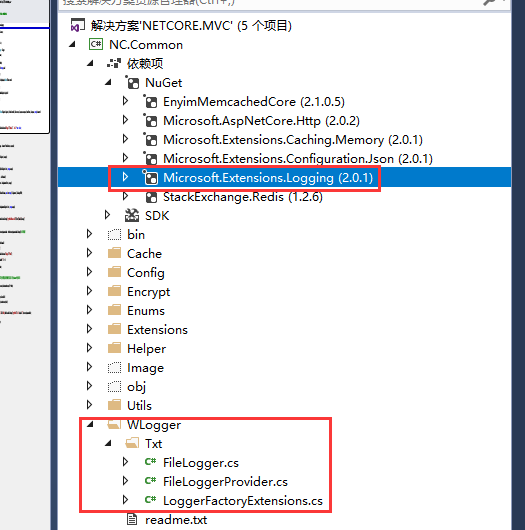Asp.Net Core 2.0 项目实战(9) 日志记录,基于Nlog或Microsoft.Extensions.Logging的实现及调用实例
Asp.Net Core 2.0 项目实战(1) NCMVC开源下载了
Asp.Net Core 2.0 项目实战(2)NCMVC一个基于Net Core2.0搭建的角色权限管理开发框架
Asp.Net Core 2.0 项目实战(3)NCMVC角色权限管理前端UI预览及下载
Asp.Net Core 2.0 项目实战(4)ADO.NET操作数据库封装、 EF Core操作及实例
Asp.Net Core 2.0 项目实战(5)Memcached踩坑,基于EnyimMemcachedCore整理MemcachedHelper帮助类。
Asp.Net Core 2.0 项目实战(6)Redis配置、封装帮助类RedisHelper及使用实例
Asp.Net Core 2.0 项目实战(7)MD5加密、AES&DES对称加解密
Asp.Net Core 2.0 项目实战(8)Core下缓存操作、序列化操作、JSON操作等Helper集合类
Asp.Net Core 2.0 项目实战(9) 日志记录,基于Nlog或Microsoft.Extensions.Logging的实现及调用实例
Asp.Net Core 2.0 项目实战(10) 基于cookie登录授权认证并实现前台会员、后台管理员同时登录
Asp.Net Core 2.0 项目实战(11) 基于OnActionExecuting全局过滤器,页面操作权限过滤控制到按钮级
本文目录
1. Net下日志记录
2. NLog的使用
2.1 添加nuget引用NLog.Web.AspNetCore
2.2 配置文件设置
2.3 依赖配置及调用
2.4 日志类型介绍
2.5 产生的日志文件
3. 基于Microsoft.Extensions.Logging封装
3.1 添加引用Microsoft.Extensions.Logging
3.2 实现我们的Logger
3.3 调用WLogger
2018-03-28 补充
4. 总结
1. Net下日志记录
Net Freamwork框架下在日志记录框架有很多,常见的有NLog、Log4Net、Loggr和内置 Microsoft.Diagnostics.Trace/Debug/TraceSource等。Asp.Net Core 2.0下大部分框架已不支持,Microsoft提供Microsoft.Extensions.Logging供大家实现自己的记录日志框架。现在笔者了解到的NLog已支持Net Core,下面我们介绍下nlog在项目中的使用以及基于Microsoft.Extensions.Logging封装自己的日志记录类。
1. NLog的使用
2.1添加nuget引用NLog.Web.AspNetCore

2.2配置文件设置
在Asp.Net Core 2.0项目实战项目中,我们把配置文件统一放在configs文件夹中,方便管理。读取时用Path.Combine("configs", "nlog.config")即可。下面是nlog.config的配置。

<?xml version="1.0" encoding="utf-8" ?> <nlog xmlns="http://www.nlog-project.org/schemas/NLog.xsd" xmlns:xsi="http://www.w3.org/2001/XMLSchema-instance" autoReload="true" internalLogLevel="Warn" internalLogFile="internal-nlog.txt"> <!--define various log targets--> <targets> <!--write logs to file--> <target xsi:type="File" name="allfile" fileName="nlog-all-${shortdate}.log" layout="${longdate}|${logger}|${uppercase:${level}}|${message} ${exception}" /> <target xsi:type="File" name="ownFile-web" fileName="nlog-my-${shortdate}.log" layout="${longdate}|${logger}|${uppercase:${level}}|${message} ${exception}" /> <target xsi:type="Null" name="blackhole" /> </targets> <rules> <!--All logs, including from Microsoft--> <logger name="*" minlevel="Trace" writeTo="allfile" /> <!--Skip Microsoft logs and so log only own logs--> <logger name="Microsoft.*" minlevel="Trace" writeTo="blackhole" final="true" /> <logger name="*" minlevel="Trace" writeTo="ownFile-web" /> </rules> </nlog>
2.3依赖配置及调用
在startup.cs中配置日志工厂,添加使用的服务配置后在项目中就可以调用。
/// <summary> /// 配置 /// </summary> /// <param name="app"></param> /// <param name="env"></param> /// <param name="loggerFactory"></param> public void Configure(IApplicationBuilder app, IHostingEnvironment env, ILoggerFactory loggerFactory) { loggerFactory.AddNLog();//添加NLog //读取Nlog配置文件,这里如果是小写,文件也一定是小写,否则linux下不识别 env.ConfigureNLog(Path.Combine("configs", "nlog.config")); }
nlog调用,如在Controller中调用,如:在HomeController中

2.4 日志类型介绍
public enum LogLevel { Debug = 1, Verbose = 2, Information = 3, Warning = 4, Error = 5, Critical = 6, None = int.MaxValue }
2.5产生的日志文件
日志的位置默认是在bin\Debug\netcoreapp2.0下面

日志文件内容根据文件名可以很方便的区分开,其中nlog-all包含的内比较多,nlog-my中就只包含了我们记录日志的内容,大家动手试一下。
3.基于Microsoft.Extensions.Logging封装
由于受老项目webform影响,记录日志是在第三方类库dll中封装好了帮助类,这样在可以在项目中任何位置方便调用,这里我的nc.common工具库WLogger基于Microsoft NET Core的日志模型主要由三个核心对象构成,它们分别是Logger、LoggerProvider和LoggerFactory。现在只实现了文件记录日志txt,数据库模式有业务需求的朋友可自己扩展。
3.1添加引用Microsoft.Extensions.Logging
扩展微软日志记录框架,集成一个自己的Logger,现在扩展的是txt形式,后续可参考完善数据库模式。添加引用dll后,增加配置文件并配置,这里我先加在appsettings.json文件中,主要是配置是否开启日志和日志记录。


3.2 实现我们的Logger
首先实现日志工厂的扩展LoggerFactoryExtensions,为net core 依赖注入LoggerFactory扩张一个方法,提供增加日志写文件方式的入口。

using Microsoft.Extensions.Logging; namespace NC.Common { public static class LoggerFactoryExtensions { public static ILoggerFactory AddFileLogger(this ILoggerFactory factory) { factory.AddProvider(new FileLoggerProvider()); return factory; } } }
然后实现ILoggerProvider接口,FileLoggerProvider提供程序真正具有日志写入功能的Logger。

using Microsoft.Extensions.Logging; namespace NC.Common { public class FileLoggerProvider : ILoggerProvider { /// <summary> /// 默认构造函数,根据Provider进此构造函数 /// </summary> /// <param name="categoryName"></param> /// <returns></returns> public ILogger CreateLogger(string categoryName) { return new FileLogger(categoryName); } public void Dispose() { } } }
最后实现ILogger接口FileLogger继承并进行封装,方便写入文本日志。

using Microsoft.Extensions.Logging; using System; using System.Collections.Generic; using System.IO; using System.Text; namespace NC.Common { public class FileLogger : ILogger { private string name; private bool IsOpen; private string WPath; public FileLogger(string _name) { name = _name; } public IDisposable BeginScope<TState>(TState state) { return null; } /// <summary> /// 是否禁用 /// </summary> /// <param name="logLevel"></param> /// <returns></returns> public bool IsEnabled(LogLevel logLevel) { return true; } /// <summary> /// 实现接口ILogger /// </summary> /// <typeparam name="TState"></typeparam> /// <param name="logLevel"></param> /// <param name="eventId"></param> /// <param name="state"></param> /// <param name="exception"></param> /// <param name="formatter"></param> public void Log<TState>(LogLevel logLevel, EventId eventId, TState state, Exception exception, Func<TState, Exception, string> formatter) { IsOpen = UtilConf.GetSection("WLogger")["IsOpen"] == "true" ? true : false; if (IsOpen) { //获取日志信息 var message = formatter?.Invoke(state, exception); //日志写入文件 LogToFile(logLevel, message); } } /// <summary> /// 记录日志 /// </summary> /// <param name="level">等级</param> /// <param name="message">日志内容</param> private void LogToFile(LogLevel level, string message) { var filename = GetFilename(); var logContent = GetLogContent(level, message); File.AppendAllLines(filename, new List<string> { logContent }, Encoding.UTF8); } /// <summary> /// 获取日志内容 /// </summary> /// <param name="level">等级</param> /// <param name="message">日志内容</param> /// <returns></returns> private string GetLogContent(LogLevel level, string message) { return $"[{DateTime.Now.ToString("yyyy-MM-dd HH:mm:ss.h3")}]{level}|{name}|{message}"; } private string DirectorySeparatorChar = Path.DirectorySeparatorChar.ToString();//目录分隔符 /// <summary> /// 获取文件名 /// </summary> private string GetFilename() { var dir = ""; WPath = UtilConf.GetSection("WLogger")["WPath"]; if (WPath.IndexOf(":") > -1) { dir = WPath; } else { //此方法不是真正的获取应用程序的当前方法,而是执行dotnet命令所在目录 dir = Directory.GetCurrentDirectory() + WPath; } if (!Directory.Exists(dir)) Directory.CreateDirectory(dir); var result = $"{dir}/WLog-{DateTime.Now.ToString("yyyy-MM-dd")}.txt".Replace("/",DirectorySeparatorChar); return result; } } }
3.3 调用WLogger
在nc.common类库中封装好logger实现后,在调用连接使用数据库在core类库中调用实例如下。
首先我们先做一下封装调用类
using Microsoft.Extensions.Logging; namespace NC.Common { public class UtilLogger<T> { private static ILogger iLog; public static ILogger Log { get { if (iLog != null) return iLog; ////第一种写法 //ILoggerFactory loggerFactory = new LoggerFactory(); //loggerFactory.AddFileLogger(); //iLog = loggerFactory.CreateLogger<DbCommand>(); //第二种写法 iLog = new LoggerFactory().AddFileLogger().CreateLogger<T>(); return iLog; } set => iLog = value; } } }
然后在DbCommand中调用就可以直接写成:
public static ILogger Log = UtilLogger<DbCommand>.Log;//日志记录
Log. LogInformation(string);
Log.LogError(string)
详细方法还可以参考


2018-03-28补充:
日志记录与全局错误处理结合,首先创建全局错误过滤类HttpGlobalExceptionFilter并在startup.cs中ConfigureServices方法下添加
services.AddMvc(options => { options.Filters.Add(typeof(HttpGlobalExceptionFilter));//全局错误过滤日志 }).AddControllersAsServices();
然后实现OnException方法并记录日志,这样系统只要报异常,日志 就会被记录下来。

using System; using Microsoft.AspNetCore.Hosting; using Microsoft.AspNetCore.Http; using Microsoft.AspNetCore.Mvc; using Microsoft.AspNetCore.Mvc.Filters; using Microsoft.Extensions.Logging; using NC.Common; namespace NC.MVC { /// <summary> /// 错误处理类 /// </summary> public class HttpGlobalExceptionFilter : IExceptionFilter { private readonly IHostingEnvironment _env; public static ILogger Log = UtilLogger<HttpGlobalExceptionFilter>.Log;//日志记录 public HttpGlobalExceptionFilter(IHostingEnvironment env) { this._env = env; } public ContentResult FailedMsg(string msg = null) { string retResult = "{\"status\":" + JHEnums.ResultStatus.Failed + ",\"msg\":\"" + msg + "\"}";//, msg); string json = JsonHelper.ObjectToJSON(retResult); return new ContentResult() { Content = json }; } public void OnException(ExceptionContext filterContext) { if (filterContext.ExceptionHandled) return; //执行过程出现未处理异常 Exception ex = filterContext.Exception; #if DEBUG if (filterContext.HttpContext.Request.IsAjaxRequest()) { string msg = null; if (ex is Exception) { msg = ex.Message; filterContext.Result = this.FailedMsg(msg); filterContext.ExceptionHandled = true; return; } } this.LogException(filterContext); return; #endif if (filterContext.HttpContext.Request.IsAjaxRequest()) { string msg = null; if (ex is Exception) { msg = ex.Message; } else { this.LogException(filterContext); msg = "服务器错误"; } filterContext.Result = this.FailedMsg(msg); filterContext.ExceptionHandled = true; return; } else { //对于非 ajax 请求 this.LogException(filterContext); return; } } /// <summary> /// 记录日志 /// </summary> /// <param name="filterContext"></param> private void LogException(ExceptionContext filterContext) { string mid = filterContext.HttpContext.Request.Query["mid"];//codding 后续完善每个action带一个id var areaName = (filterContext.RouteData.DataTokens["area"] == null ? "" : filterContext.RouteData.DataTokens["area"]).ToString().ToLower(); var controllerName = (filterContext.RouteData.Values["controller"]).ToString().ToLower(); var actionName = (filterContext.RouteData.Values["action"]).ToString().ToLower(); #region --记录日志 codding 后续增加自定义字段的日志。如:记录Controller/action,模块ID等-- Log.LogError(filterContext.Exception, "全局错误:areaName:" + areaName + ",controllerName:" + controllerName + ",action:" + actionName); #endregion } } }
4.总结
不管是生产环境还是开发环境,总会碰到这样或那样的问题,这时日志记录就为我们提供了记录分析问题的便利性,net core 2.0下记录日志功能是最需要我们及时实现的功能,这样为我们接下来的学习提供技术支撑。另外net core 生态还不完善,很多功能需要我们自己动手去实现,在这里希望大家多动手去实现去分享,文中有不清楚或有问题欢迎留言讨论。
参考:
https://msdn.microsoft.com/magazine/mt694089
https://www.cnblogs.com/artech/p/inside-net-core-logging-2.html










【推荐】国内首个AI IDE,深度理解中文开发场景,立即下载体验Trae
【推荐】编程新体验,更懂你的AI,立即体验豆包MarsCode编程助手
【推荐】抖音旗下AI助手豆包,你的智能百科全书,全免费不限次数
【推荐】轻量又高性能的 SSH 工具 IShell:AI 加持,快人一步
· 从 HTTP 原因短语缺失研究 HTTP/2 和 HTTP/3 的设计差异
· AI与.NET技术实操系列:向量存储与相似性搜索在 .NET 中的实现
· 基于Microsoft.Extensions.AI核心库实现RAG应用
· Linux系列:如何用heaptrack跟踪.NET程序的非托管内存泄露
· 开发者必知的日志记录最佳实践
· TypeScript + Deepseek 打造卜卦网站:技术与玄学的结合
· Manus的开源复刻OpenManus初探
· 写一个简单的SQL生成工具
· AI 智能体引爆开源社区「GitHub 热点速览」
· C#/.NET/.NET Core技术前沿周刊 | 第 29 期(2025年3.1-3.9)